This vegan brioche is as buttery tasting and tender as a traditionally made loaf. It’s soft and a bit chewy, delicious plain or toasted and topped with jam or cashew cheese.
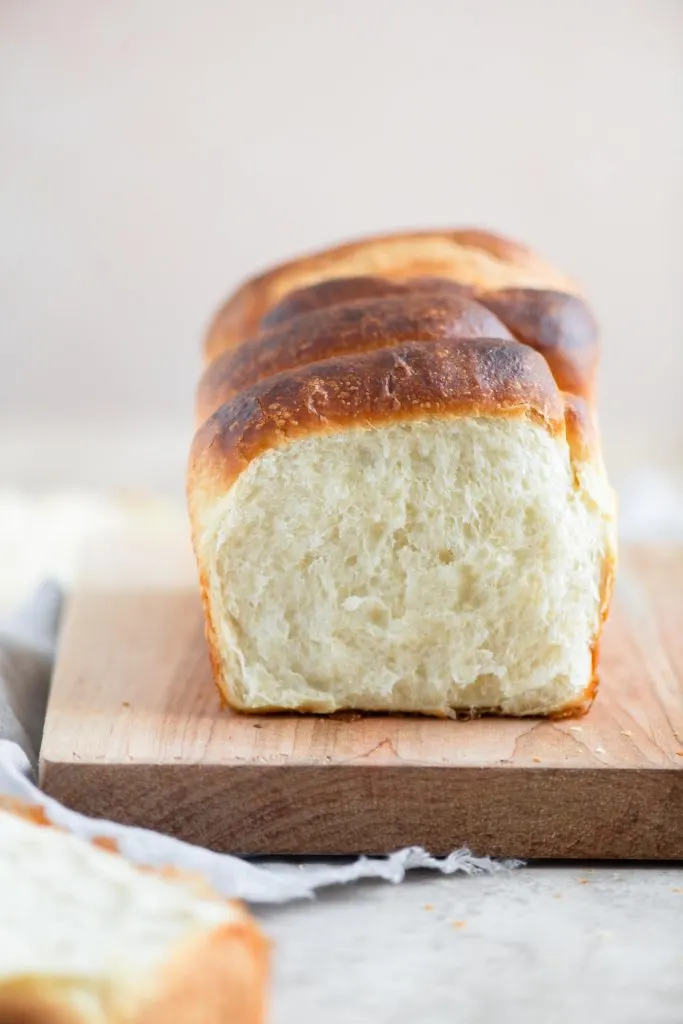
Before we begin, I give a lot of information and step-by-step instructions in the post. If you prefer to just skip to the recipe, then hit the jump to recipe button which you will find just under the title.
Guess what! You can have all the decadence of traditional egg and butter laden brioche without any of the animal based ingredients.
My recipe for homemade vegan brioche makes for a super soft, buttery tasting bread with a touch of sweetness. I personally think it tastes like croissant bread, which is incredible and possibly the biggest compliment I could give bread!
If you can resist devouring the whole loaf while it’s still warm, well, congratulations you have great self control!
Tear into the fresh loaves or cut thick or thin slices. Eat it plain or smeared with jam or cashew cream cheese. Toast it or enjoy it fresh. Got leftovers? Then make French toast!
Brioche is not the fastest bread to make, and it’s highly recommended that you have either a stand mixer or a bread machine to make it because the dough is wet and sticky. That being said, it’s easy to make and worth every second of effort!
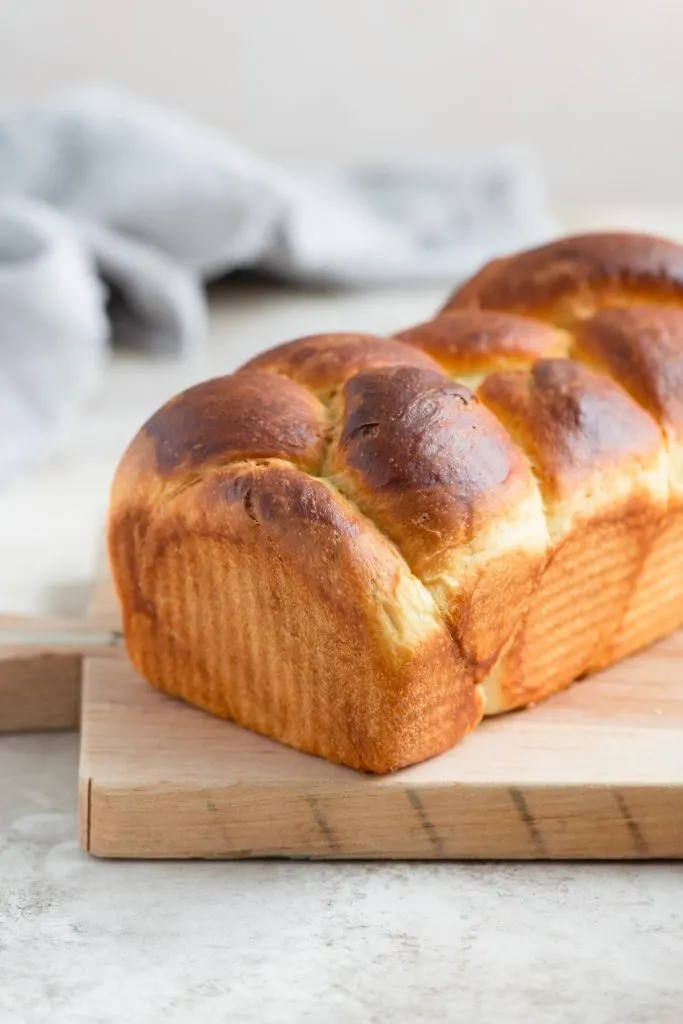
What is brioche?
Brioche is an enriched yeasted French bread, meaning it is made with milk, butter, and egg. It’s somewhat unique in enriched breads as the eggs actually make up most of the liquid in the bread and the milk is added in small quantities or sometimes not at all.
The butter is kneaded into the dough in large quantities, and the amount of butter can vary depending on how rich you want the dough. Historically there were “peasant” varieties of brioche with lower quantities of butter (because who could afford more!) and a rich person’s version that was richer and sweeter.
The science of brioche:
In order to understand how to make a vegan brioche recipe we need to understand the why of how the bread works.
Brioche is a study in balancing opposites. We want a tender bread which means adding lots of butter to the dough. However, when you add fat to the dough it effectively “shortens” the strands of gluten in the dough.
Gluten is the protein structure in wheat flour, and it provides the scaffolding and structure of bread. As yeast in the dough produces gas, the protein network is able to trap this gas and create the airy, soft texture of bread we all know and love.
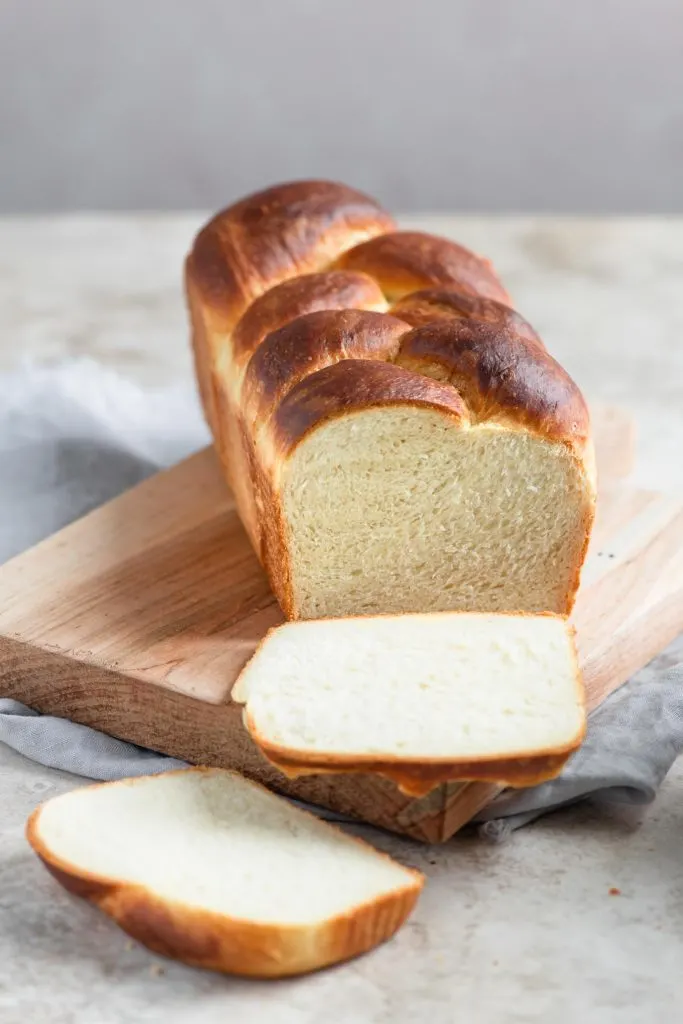
In lean breads (without any milk, butter, or egg) this is what can give large pockets of air for a very holey bread. However if you want truely soft, tender, almost cakey bread you need to shorten these strands of gluten.
It’s partially why cake is soft, why scones are tender, and pie dough isn’t tough.
The problem is, if you add too much butter the bread loses its ability to hold shape. And this is where the egg comes in.
The protein in the egg helps stabilize the structure of the dough. Egg also adds additional fat, making for an even softer bread.
Milk is used instead of water, because this also creates a softer dough.
To sum it up, we have a dough with is supported with the gluten protein network and the protein from the eggs. To keep the dough as soft as possible we add fat in the form of butter and egg yolks. Too much fat and the bread doesn’t turn out. Not enough and you haven’t made brioche.
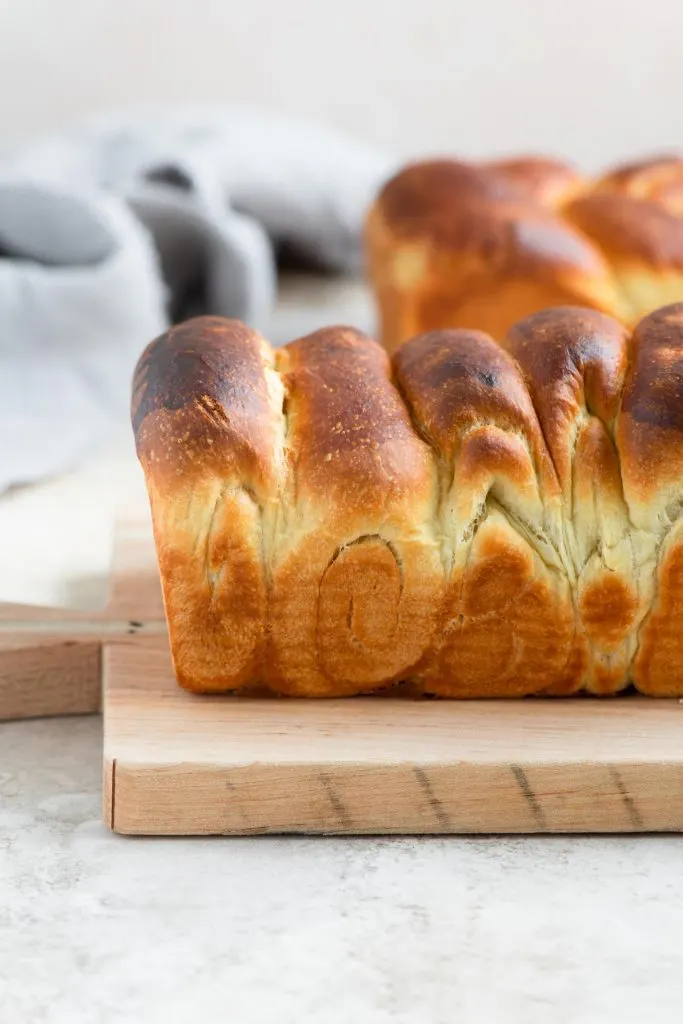
The science of vegan brioche:
So how do you turn a recipe that requires the specific properties of egg vegan? There are certainly a lot of approaches one can take, and I’m sure most will turn out tasty bread.
With my recipe I want to imitate the role of each non-vegan ingredient as closely as possible. So let’s tackle each ingredient one at a time.
Substituting the milk:
Starting with the easiest ingredient to substitute, milk! There are so many plant based milks out there and any of them can be used to make vegan brioche.
I have favorites though, and my number 1 is soy milk. Soy milk is most similar nutritionally to cow’s milk. It’s high in protein, has some natural fat, it’s creamy, and is a great choice for all vegan baking and cooking.
Pea-based milks will function similarly to soy milk and will also be a good choice.
My second choice for plant milk is oat milk. It’s also creamy and has natural fats that are important in baking. It’s lower in protein than soy milk but still a good choice.
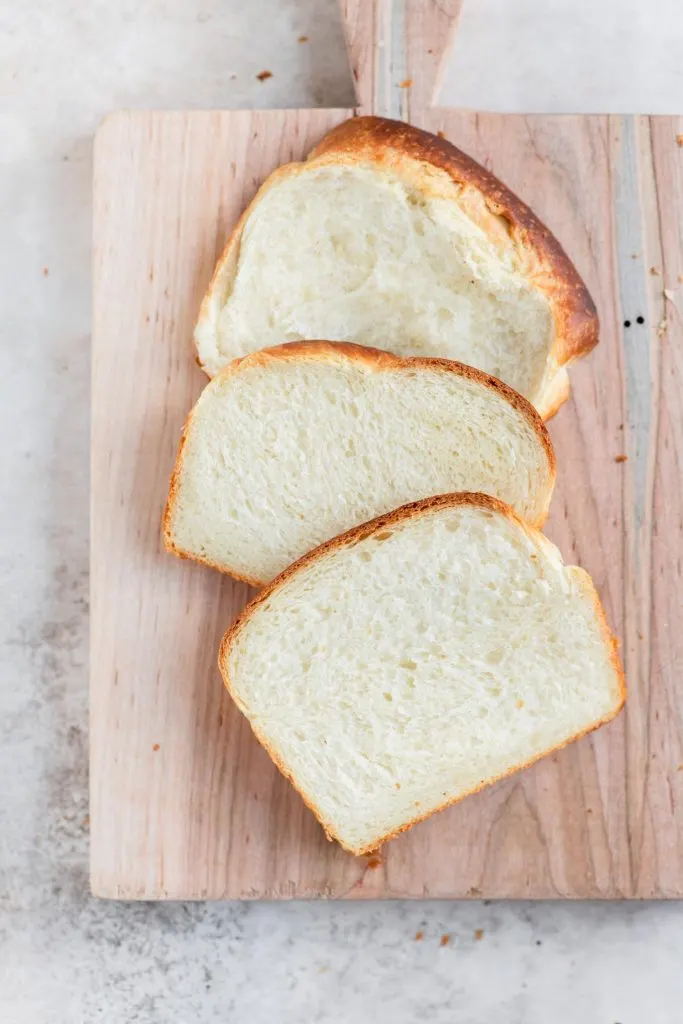
Substituting the butter:
This one is easy too. You just need to use vegan butter!
When choosing your vegan butter I recommend using a kind meant for baking and not the kind that’s formulated for spreading. This means the kind in a block or stick and not in a tub.
The butters in tubs are either whipped to incorporate more air, formulated with softer fats, or have higher water content.
All that being said, if only vegan butter found in a tub is available to you, that’s ok you can use that. Other than that, the brand you use is personal preference.
Note: most vegan butter is salted, so that is what I used to develop this recipe. If you use an unsalted vegan butter you will want to increase the salt.
There are recipes that use extra virgin olive oil instead of butter to make a vegan loaf. However, a big factor in using butter (beyond the flavor) is that we want the fat to be firm after refrigerating. And saturated fat (which butter has and is why it is solid at room temperature) is just going to have a different mouthfeel and effect than liquid fats.
Substituting the egg:
This is the trickiest ingredient to substitute as it plays multiple rolls. Eggs provide fat, protein for structure, and even a little bit of leavening (though that’s not important for brioche).
One ingredient can’t do all of those things, unless you take advantage of the newer science-y vegan eggs! Which are cool, but not super accessible or affordable for everyone. And is not how I wanted to design my recipe anyway!
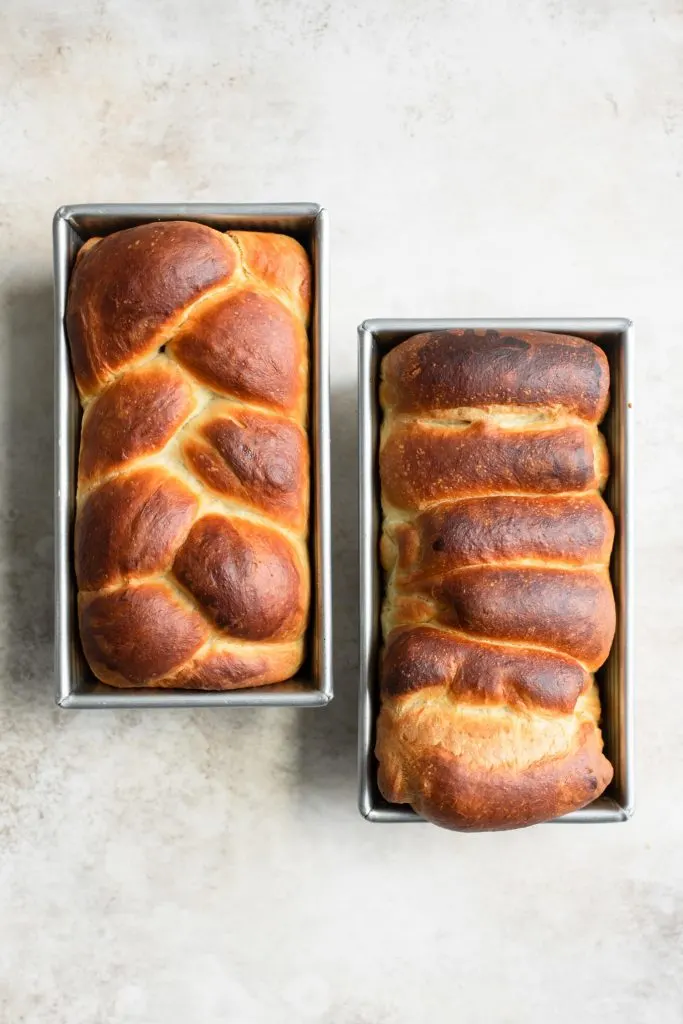
Instead I chose a few ingredients to fill the role of eggs: silken tofu, additional plant milk, vinegar (use apple cider vinegar or white vinegar), and bread flour.
Silken tofu is a great egg replacer when you want a cakey texture. Like egg yolks it has fat and protein. It will effectively shorten the gluten network and provide a custardy protein structure. Trust me, you would never guess there’s tofu in this bread!!
But you don’t want to use too much silken tofu, because it doesn’t work as well as egg for providing liquid. Instead we add additional plant milk to make up for the liquid.
Blend the silken tofu and plant milk together until smooth before adding to the dry ingredients.
I like to add a little bit of vinegar to the tofu-milk mixture, because vinegar tenderizes bread. It’s not the end of the world if you forget to add it, but it’s the little things that add up to a perfect loaf.
Lastly, add some bread flour. Bread flour is higher in protein (more gluten!) than all purpose flour and helps support the bread with all those softening ingredients we’re adding.
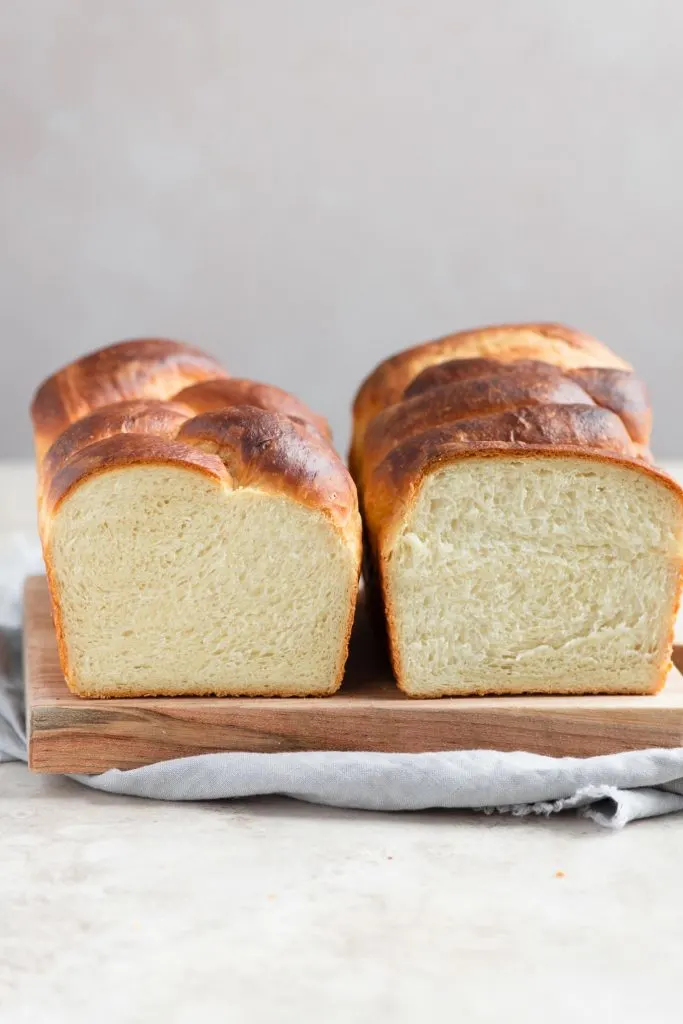
How to make homemade vegan brioche:
Now that we have our action plan of veganizing the brioche, how do you actually make it?
First you need to knead together all of the dough ingredients except for butter. Don’t add the butter right away because we need to develop the gluten first. As soon as we add the butter we start working against the gluten network.
Once the dough is kneaded for a few minutes you can start to slowly add softened vegan butter. You want it soft, so that if you press a finger into it sinks right in to reshape the butter. This will help the butter be kneaded evenly into the dough.
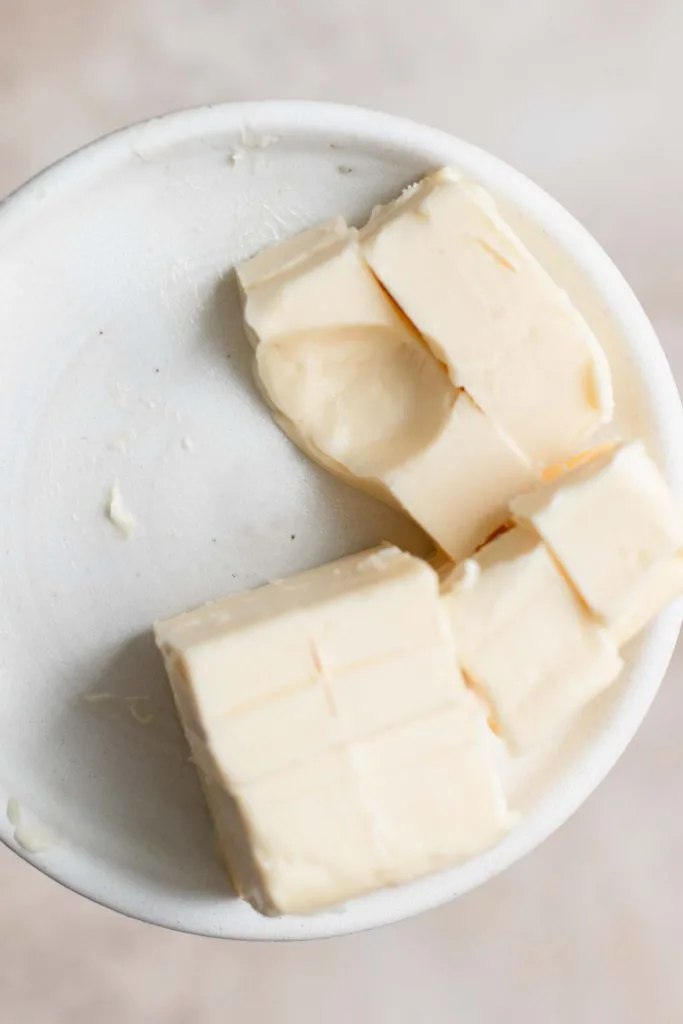
At this point the dough should be soft and a bit tacky but not stick too much to your fingers. It’s best to have the dough a bit wetter than too stiff.
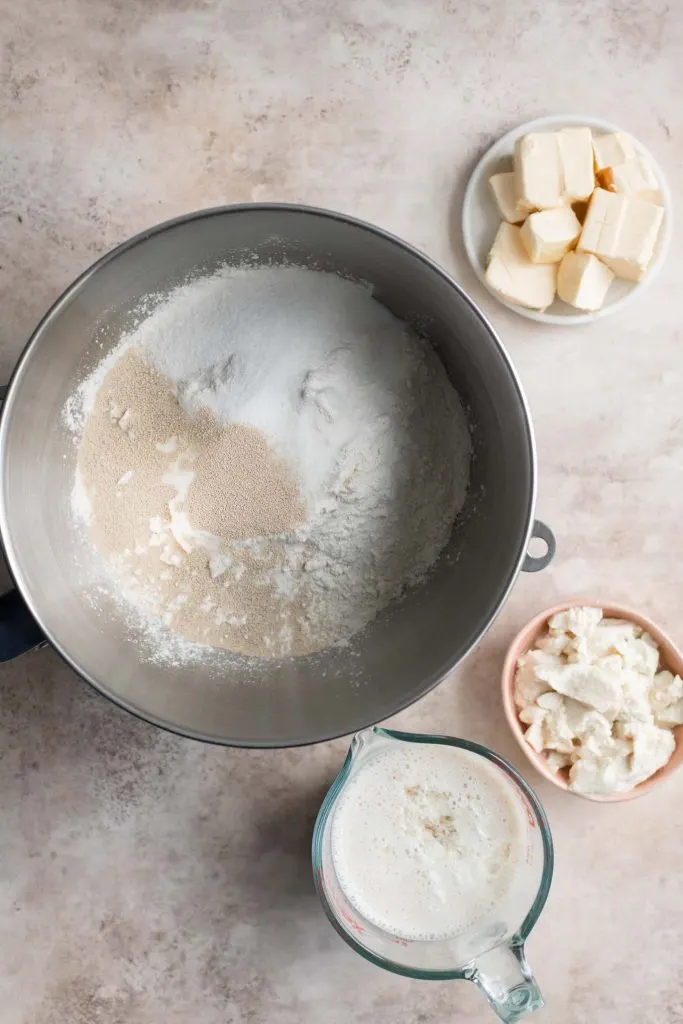
mix dry ingredients together 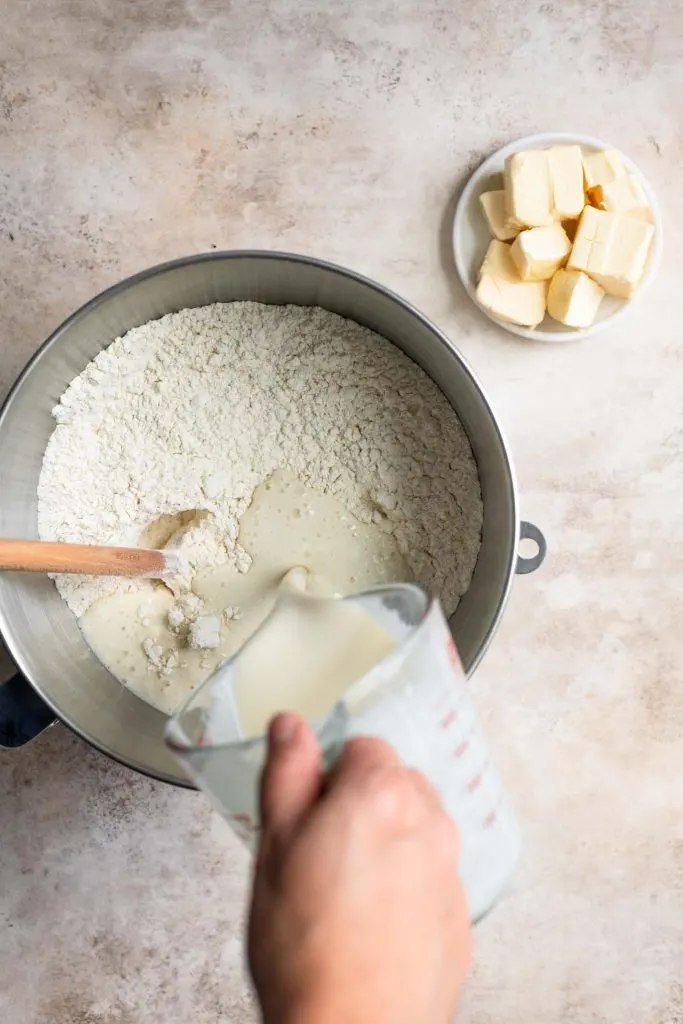
add blended liquids 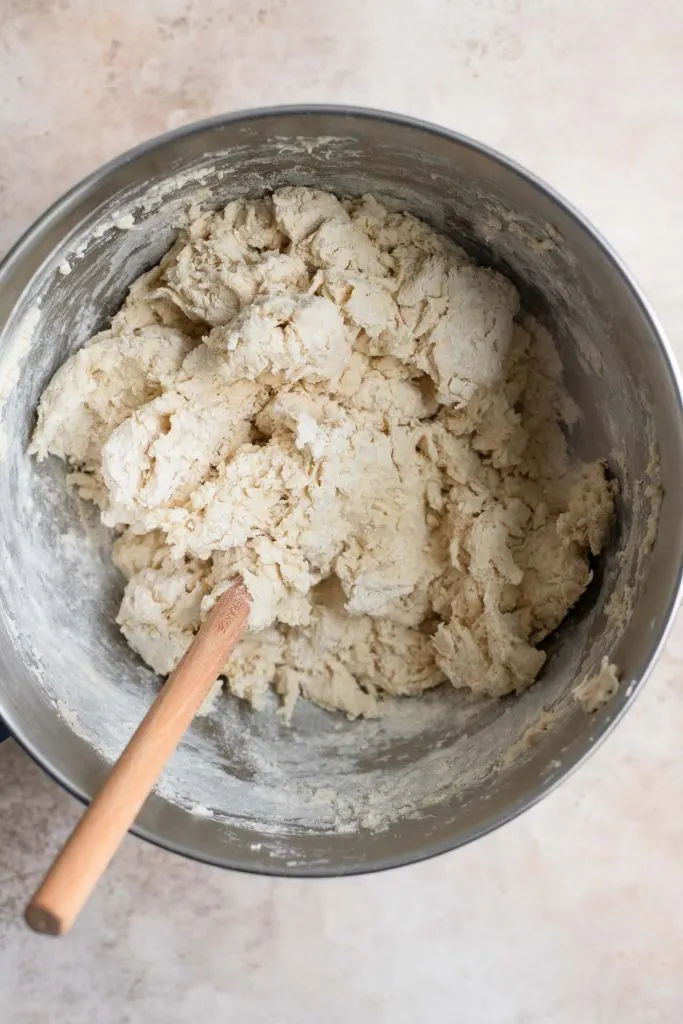
mix until shaggy
Kneading in the vegan butter can take time, maybe as much as 10 minutes. And you may need to help it along by occasionally stopping the mixer and burying pats of butter into the dough by hand.
Once all of the vegan butter is incorporated into the dough, it needs more kneading. You knead it for longer than most doughs thanks to those ingredients that want to inhibit the gluten development! Approximately another 15 minutes.
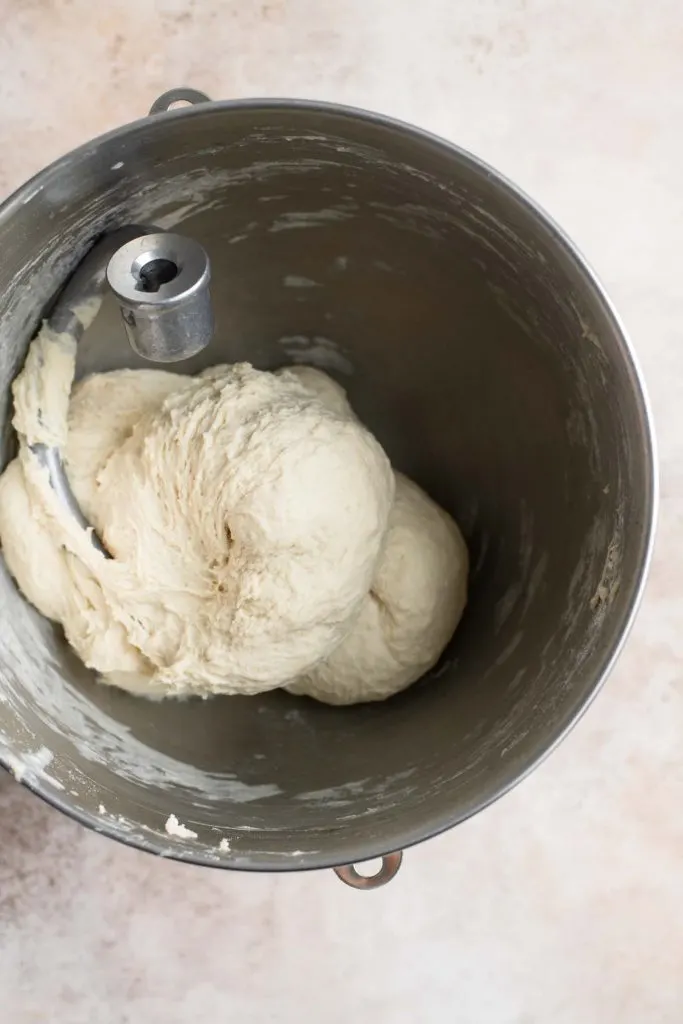
kneaded without vegan butter 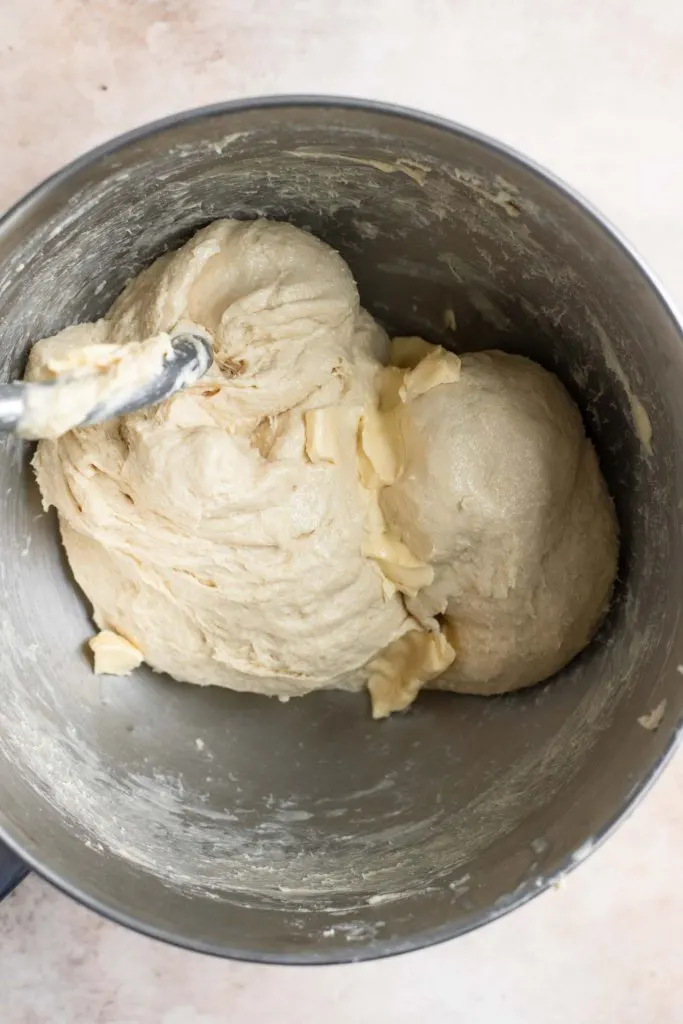
half the vegan butter kneaded in 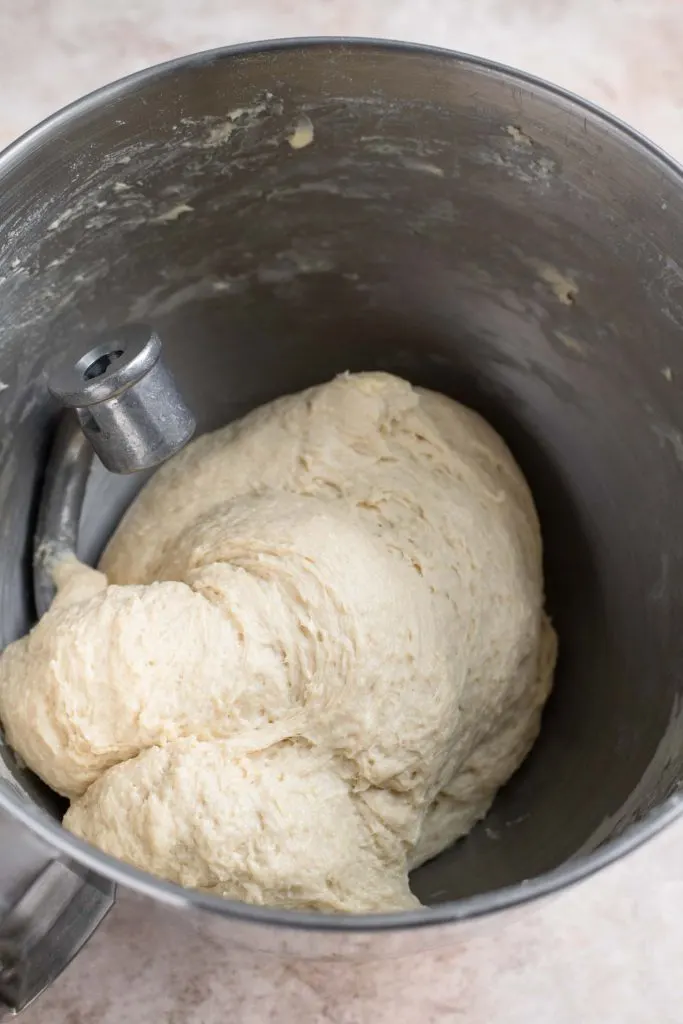
vegan butter just kneaded in 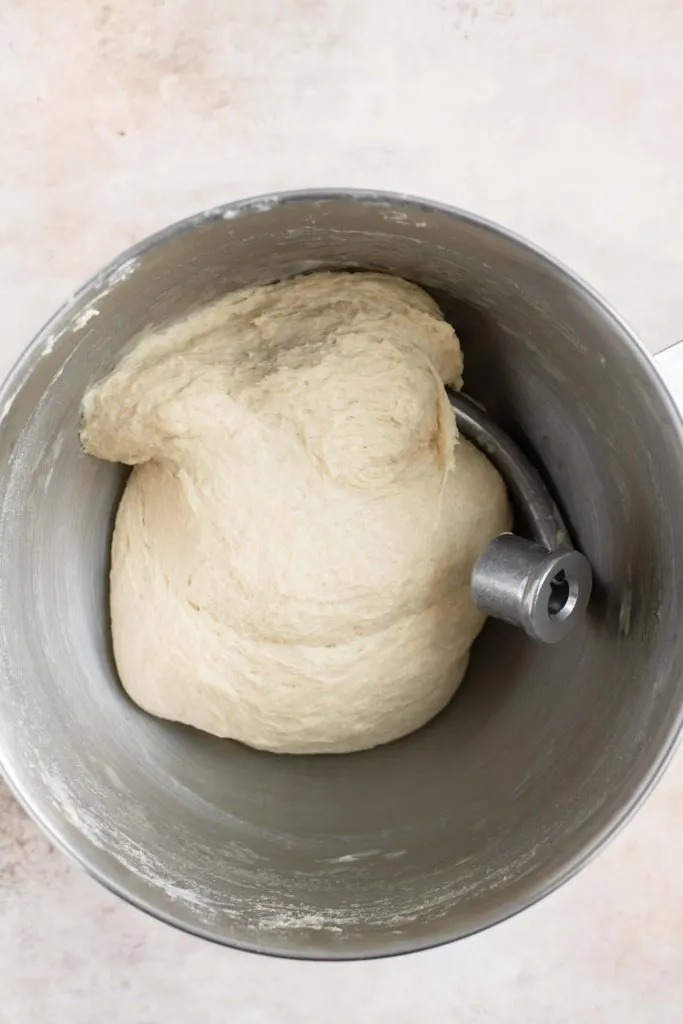
smooth dough after all the kneading
The tofu keeps the dough from looking as smooth as non-vegan or non-tofu containing doughs will look. This is normal and okay! so don’t stress if it doesn’t get perfectly smooth at the end of all that kneading.
The first proof:
Once you’re done kneading most of the work is done! Shape it into a ball, coat in a drizzle of oil, and let it rise a room temperature for about an hour. This lets the yeast get a head start and the dough should start rising.
The dough then needs to be refrigerated for at least 4 hours so that the yeast can fully rise and the soft dough can firm up as the butter chills. However, ideally it should rise overnight (or up to a day) in the fridge. The longer fermentation time will let the dough develop more flavor.
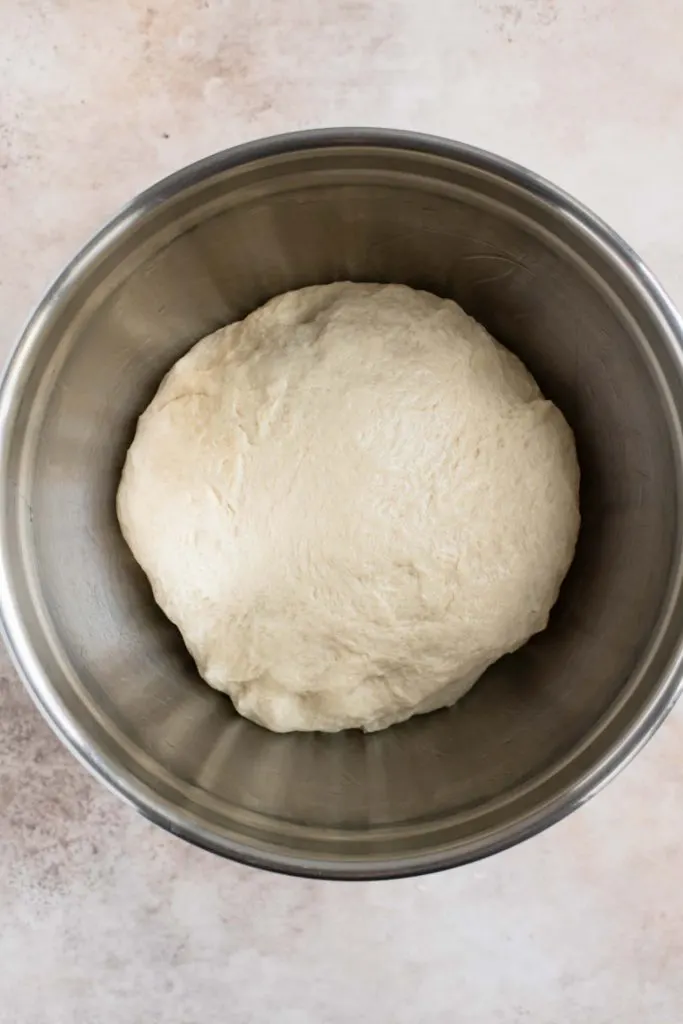
before proving 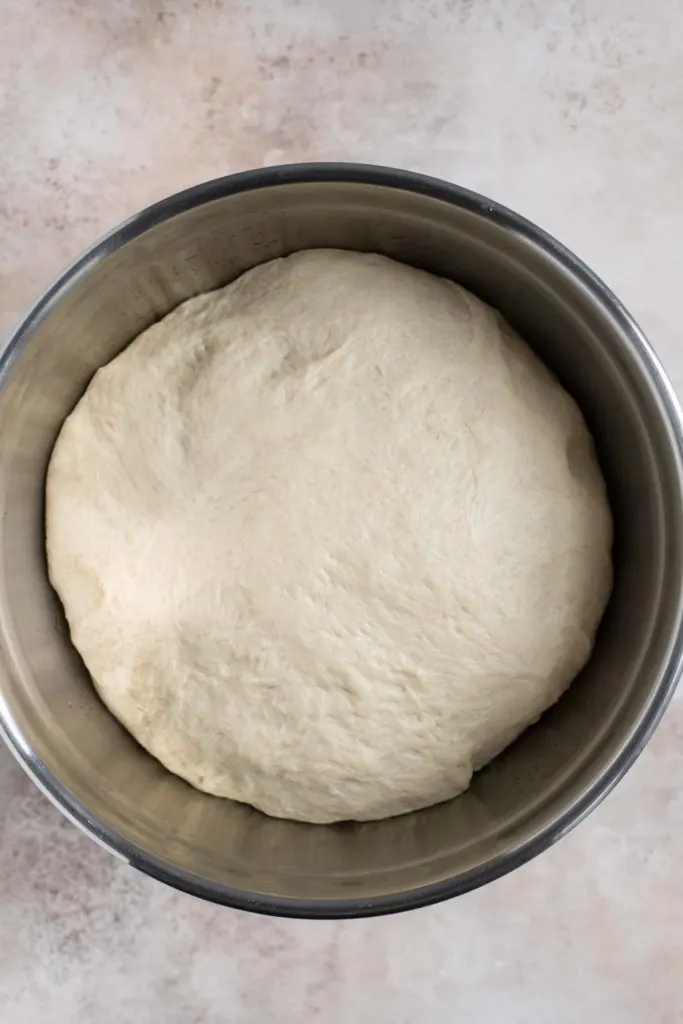
after 1 hour proving at room temperature 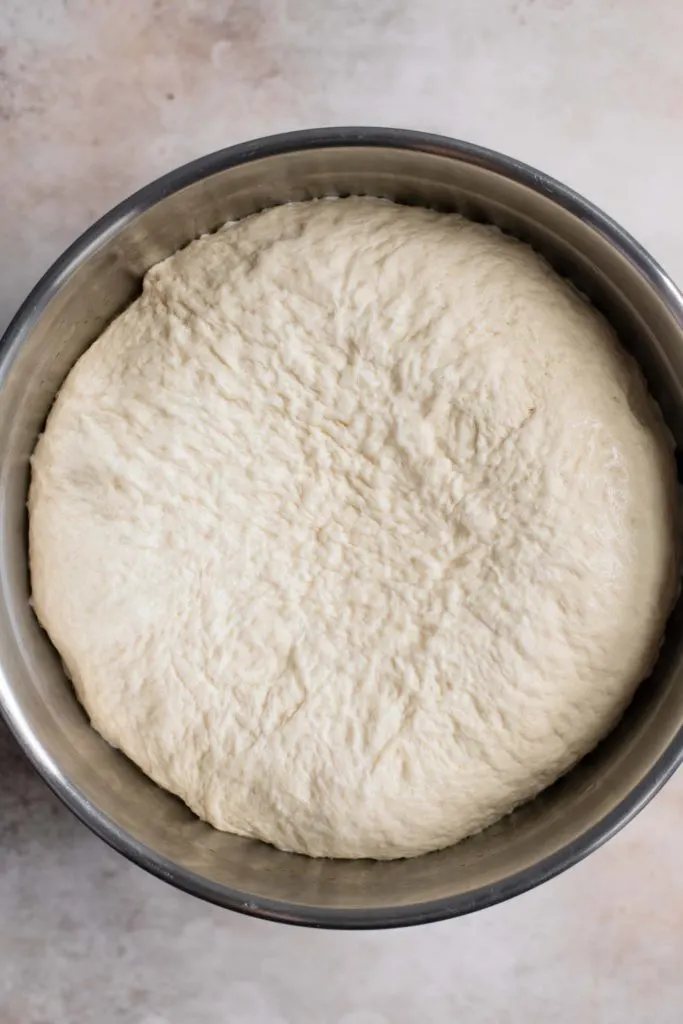
after overnight in fridge
Shaping vegan brioche:
This recipe makes two loaves of bread, which you can shape the same way or differently. I suppose you could cut the recipe in half and bake one loaf… but then you wouldn’t have a loaf for french toast!
There are many ways you can shape brioche, the most simple being to just shape it as a bread loaf. Flatten the dough into a rectangle, fold the short ends into the center in thirds like it’s a letter, flatten it out again then roll it up to make a log. Place this seam side down in the greased loaf pan.
I will show two other methods: a braid and a segmented bread. Note: this isn’t the only way to segment bread, but I can only show so many things!
The braid:
Divide the dough into three pieces, and roll each one about 14 inch long. Line them up parallel to each other and about 1/3 of the way down from the top start your braid. Braid to the bottom and pinch the ends together.
Then go back to the top and reverse your braid so you follow the same pattern. This means where you went over with a strand you need to go under. When you finish the top of the braid pinch those ends together.
Tuck the pinched ends under the loaf. If the loaf has gotten longer than your loaf pan, gently plump it up by pressing the ends together with your hands.
*I like to braid first the bottom 2/3 of the loaf then go back and braid the top half because I find this gives a more evenly braided loaf. If this seems too complicated to you, tightly pinch the pieces together at the top and braid all the way down from the top. You will likely have one skinner side and one fatter side with this method.
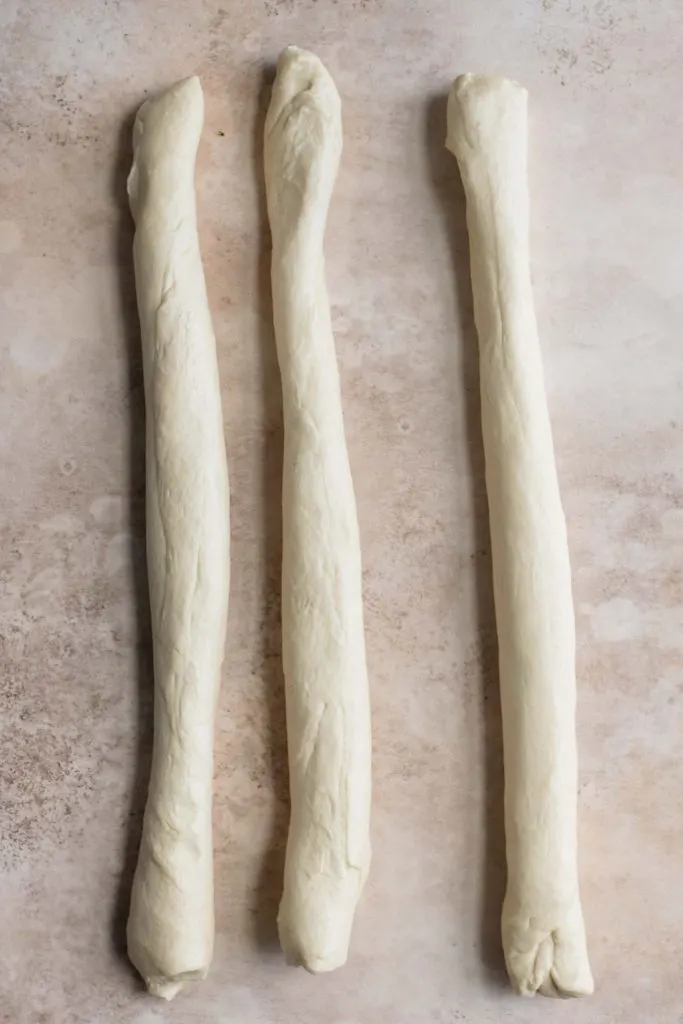
three strands of dough 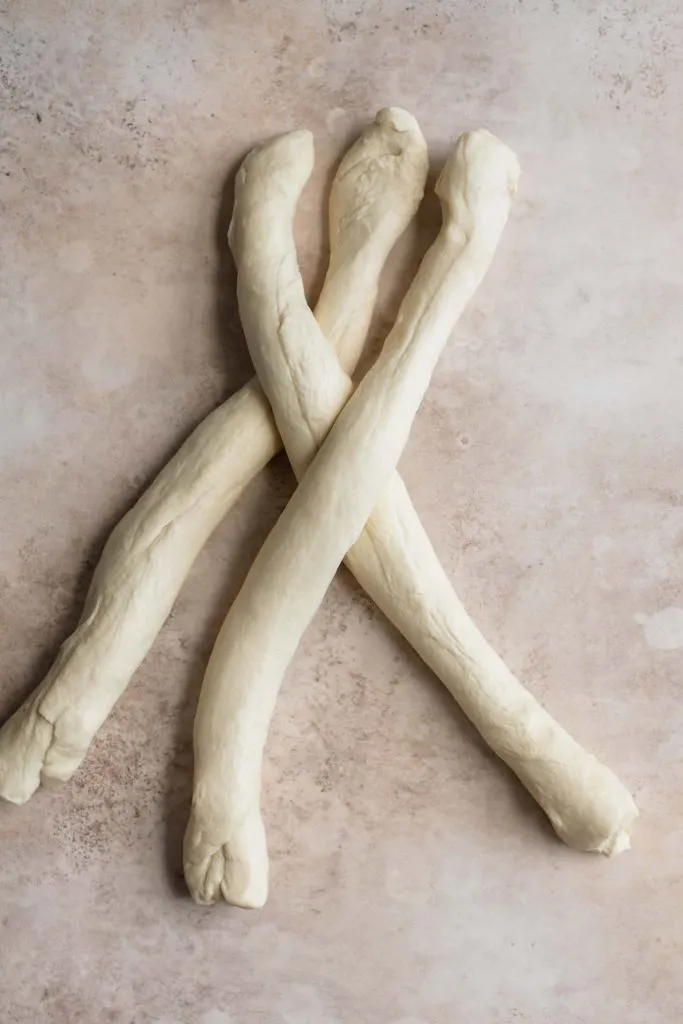
make the first knead partway down 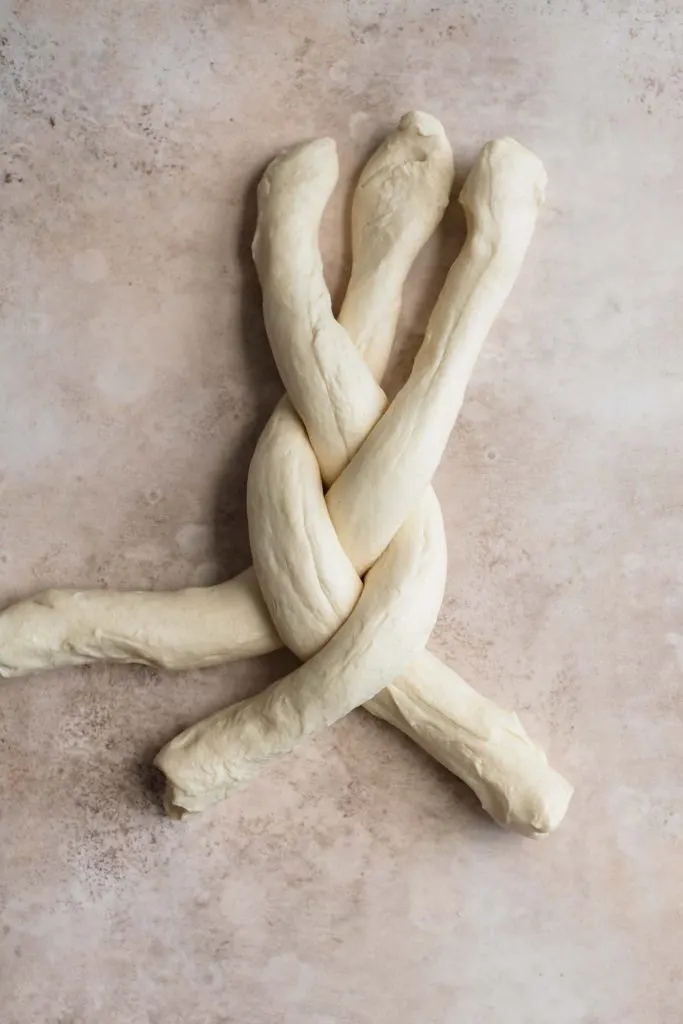
braid bottom half of dough 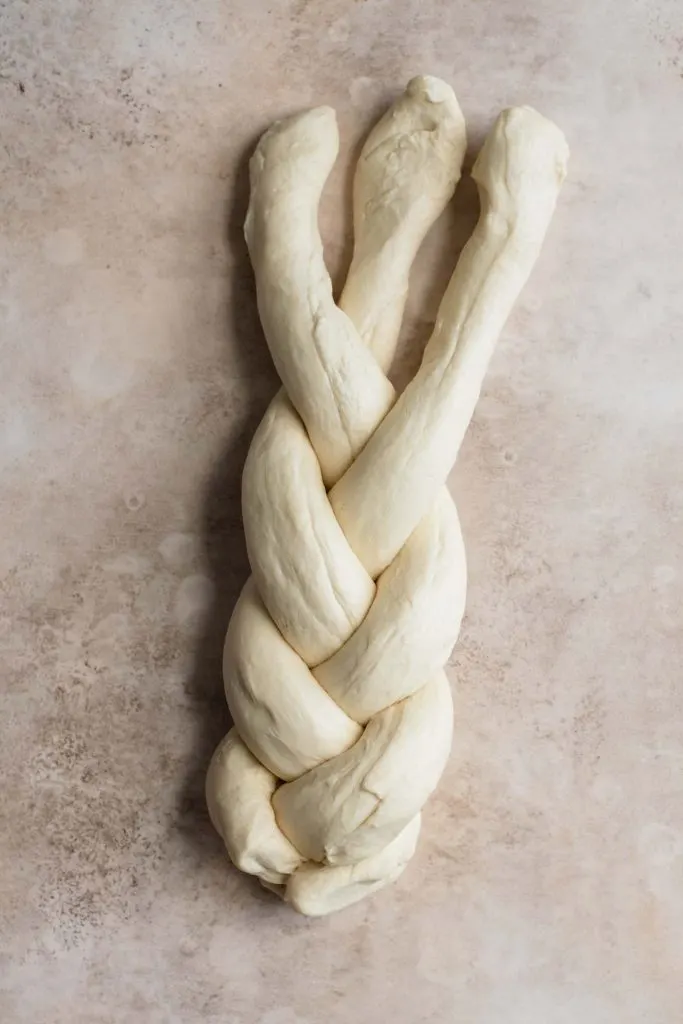
seal the end 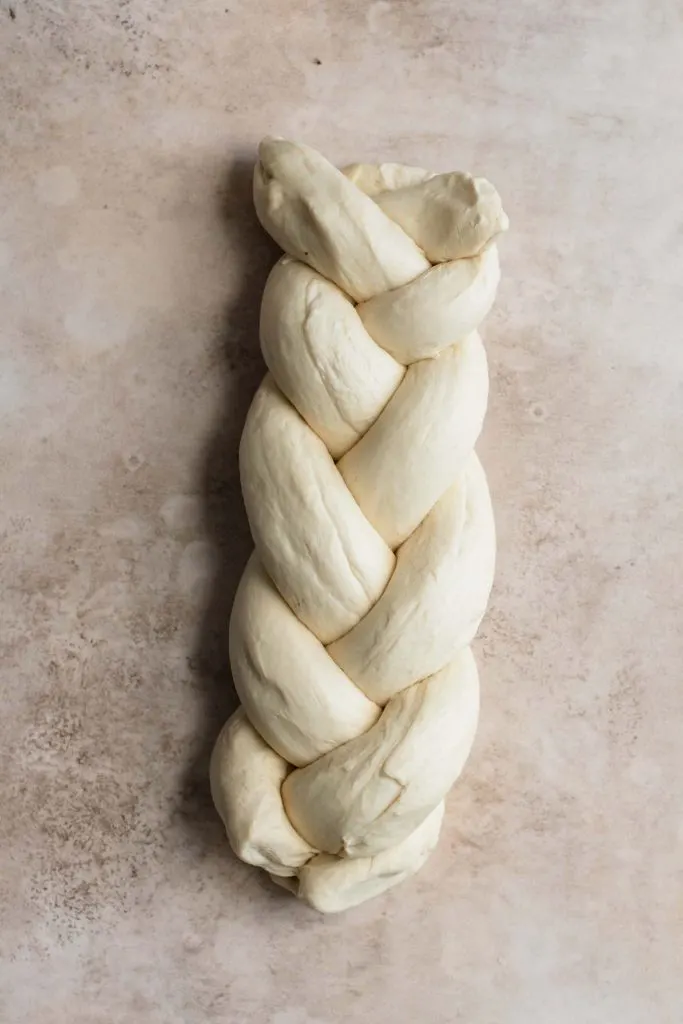
braid the top half 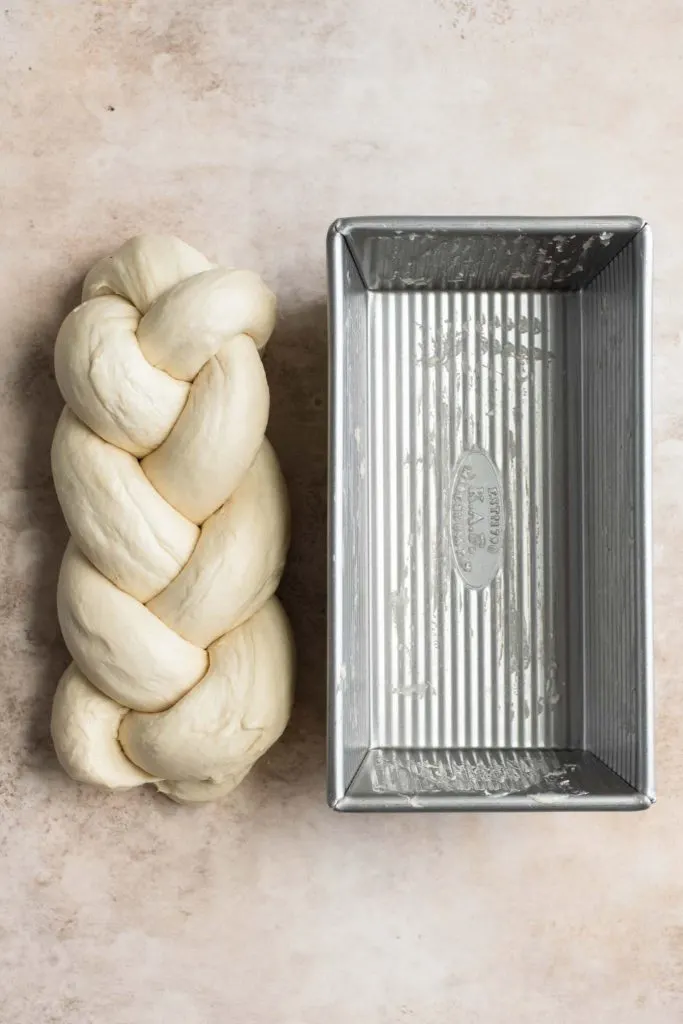
tuck sealed ends under braid
Segmented Brioche:
There has to be a better name for this one! But regardless, divide the dough into six pieces.
Working with one piece at a time flatten it into a rectangle. You can do this by pressing it with your hands, or if you prefer using a rolling pin. Fold the short edges into the center like you would fold a letter.
Flatten this out into a rectangle again, it should be about as wide as your loaf pan. Then roll it up from the short edge (like you would a yoga mat). Roll it tightly but without stretching the dough as you roll.
Place the rolls into the greased loaf pan seam side down. It’ll be a tight fit and the rolls will get compressed a bit flat. This is ok!
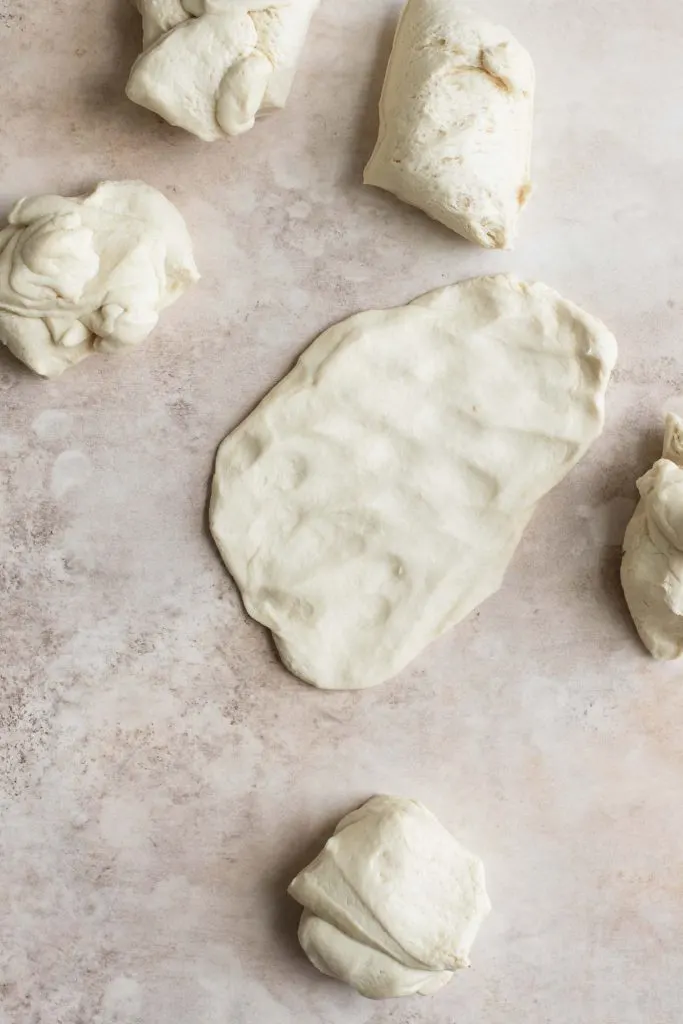
shape into a rectangle 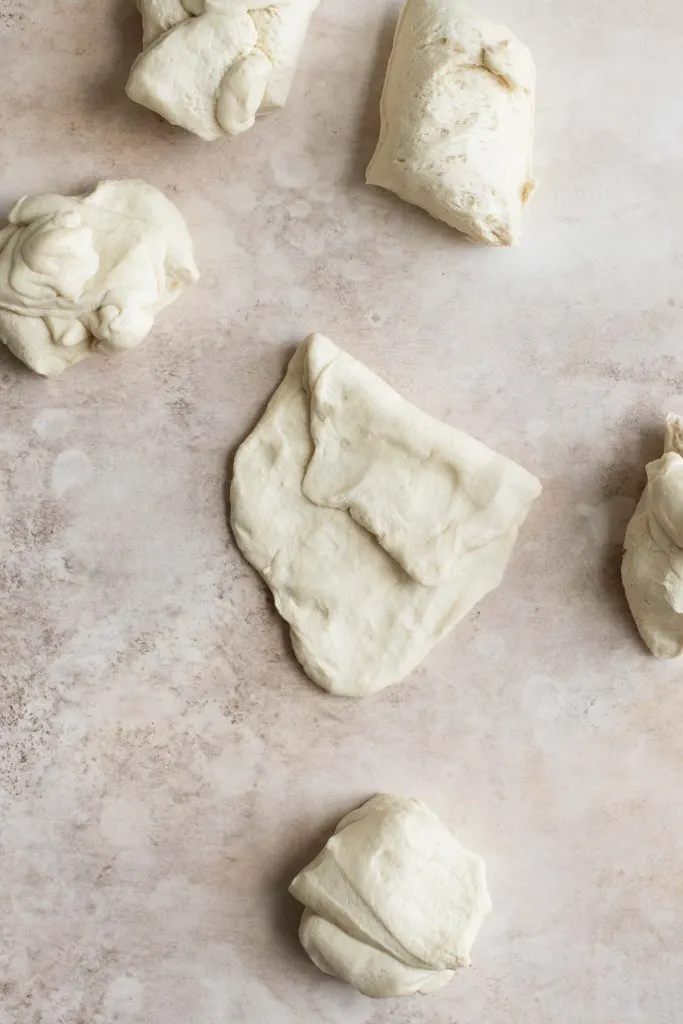
fold short end into center 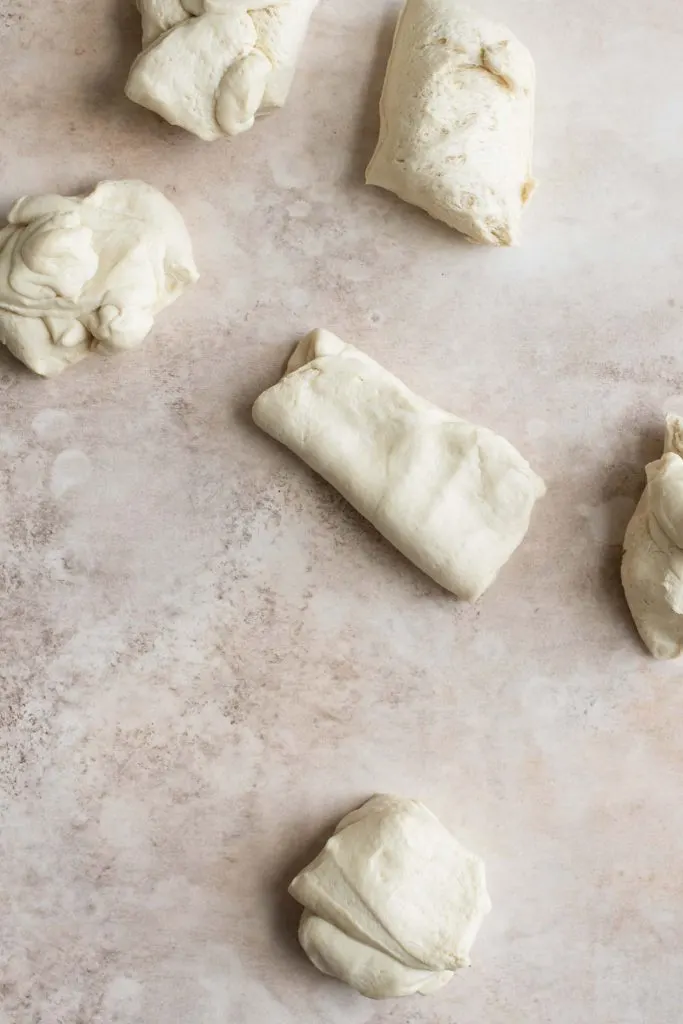
fold second side in 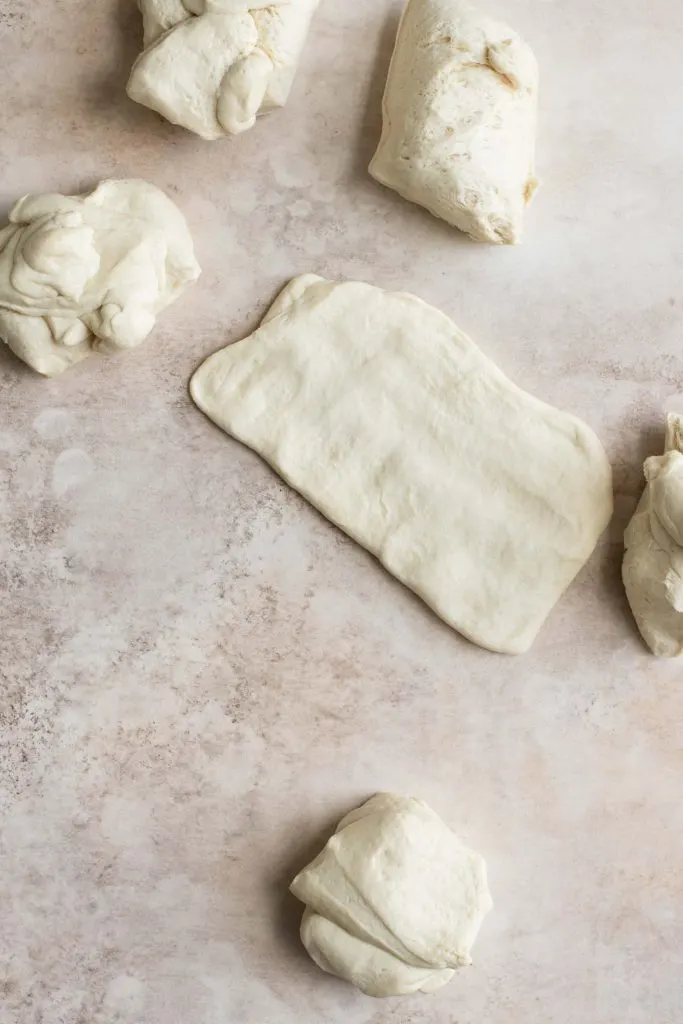
flatten back into rectangle 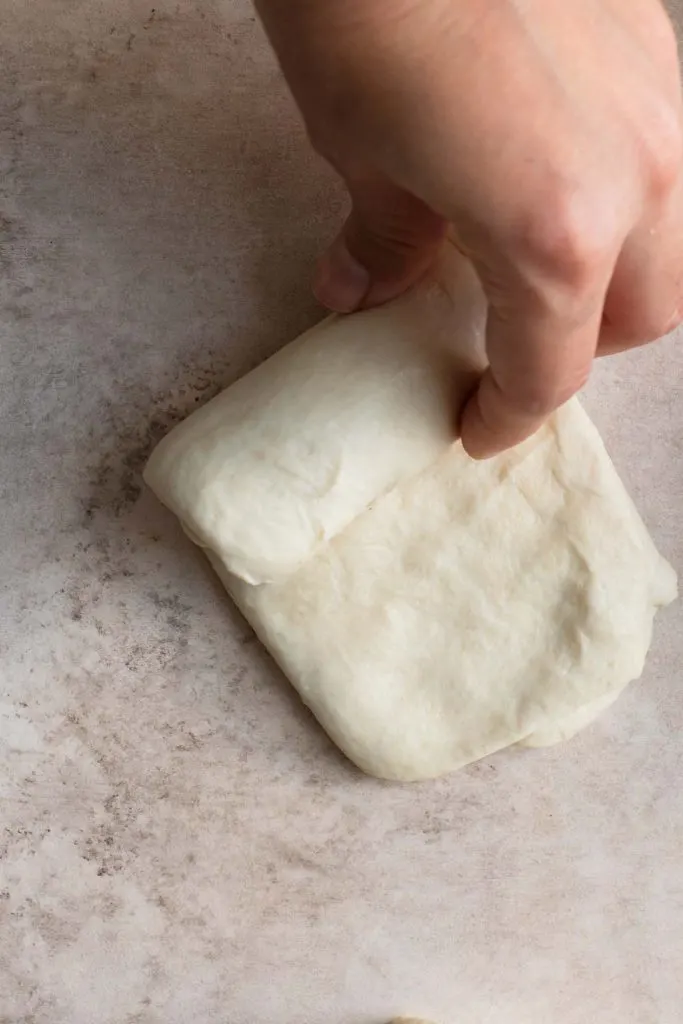
roll up the short end 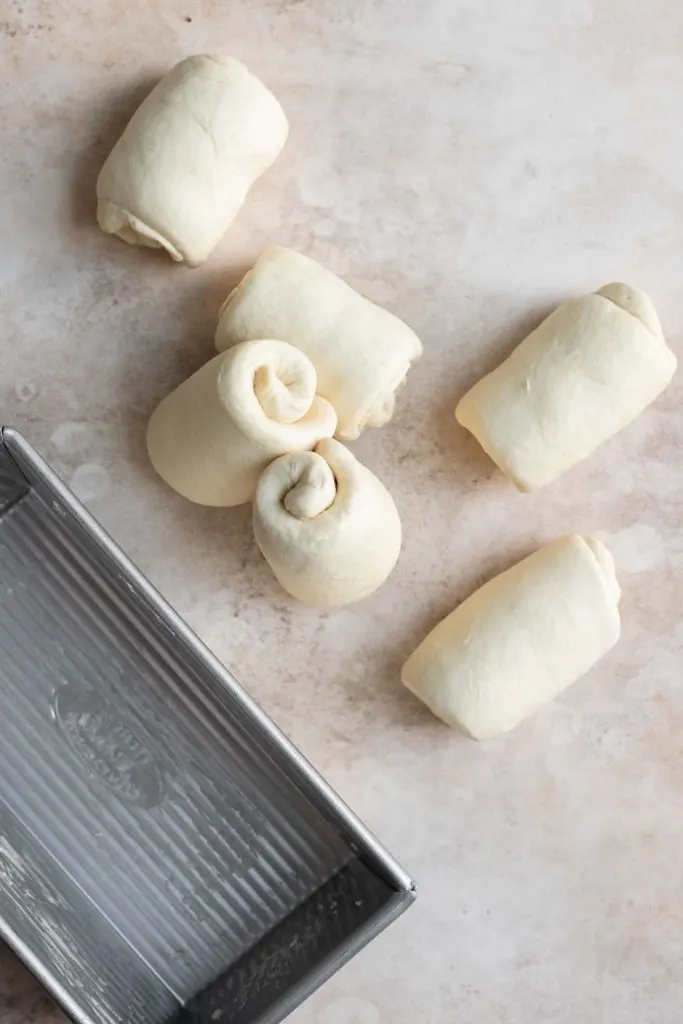
fit rolls seam side down into loaf pan
The second proof:
Whichever way you’ve shaped the vegan brioche dough it will need a second rise before baking. Let it rise until the dough has about filled up the pan. How long this takes will depend on how active your yeast is and how cold your kitchen is. It may be as sort as 1 hour or as long as 3 or 4 hours.
Keep in mind that the finger poke test doesn’t work that well with cold dough, as it is more likely to hold its shape whether or not it’s done proving.
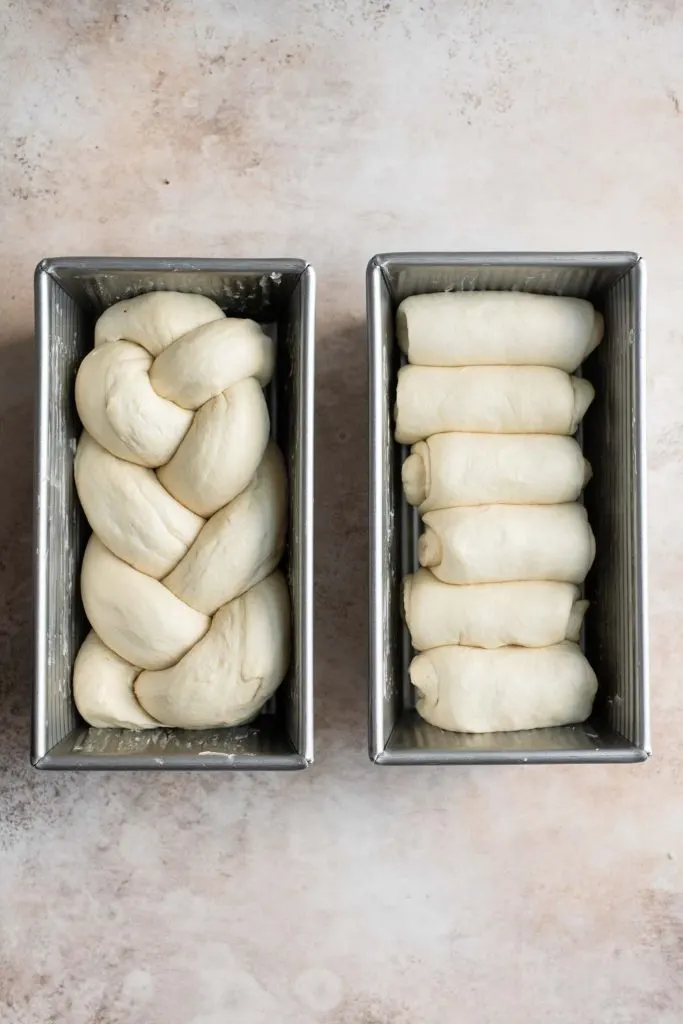
before proving 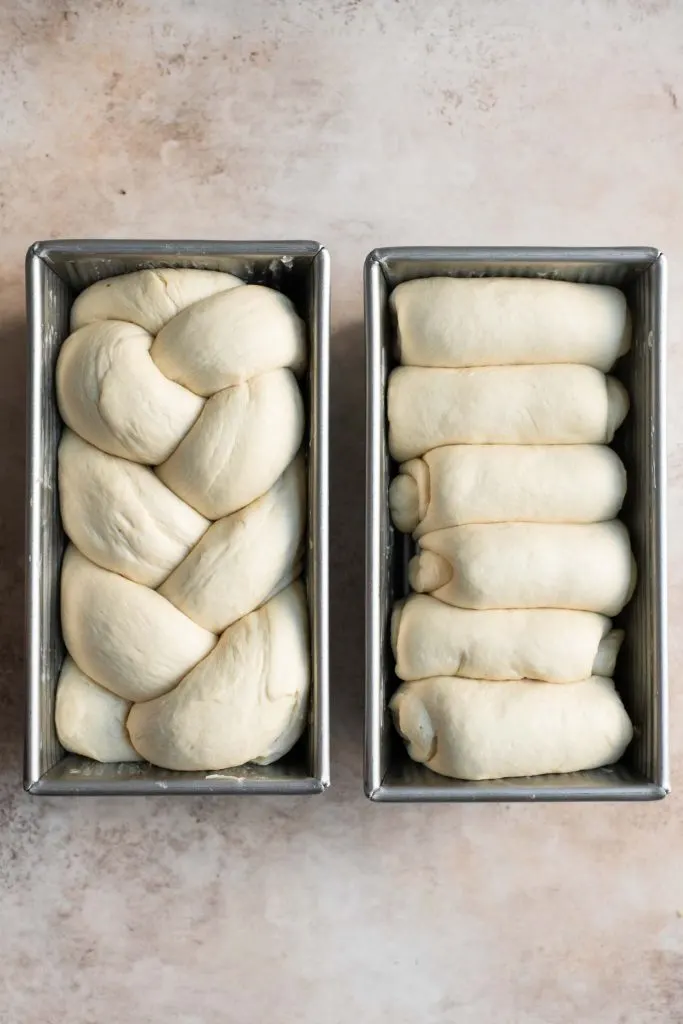
after proving
Can I substitute the silken tofu?
So far I haven’t tested this vegan brioche recipe with a substitute for silken tofu, but my go to substitute for it is non-dairy yogurt. A vegan sour cream may work as well. Both of these may impart a bit more flavor to the dough, and you may want to leave out the vinegar if you use one of these.
If you make this homemade vegan brioche, leave a comment below and rate the recipe on the recipe card. And please share your photos with me on Instagram, tag @thecuriouschickpea and #thecuriouschickpea. I love seeing your recreations!
WANT MORE DELICIOUS VEGAN RECIPES?
SIGN UP FOR MY EMAIL NEWSLETTER & FOLLOW ME ON INSTAGRAM, FACEBOOK, AND PINTEREST!
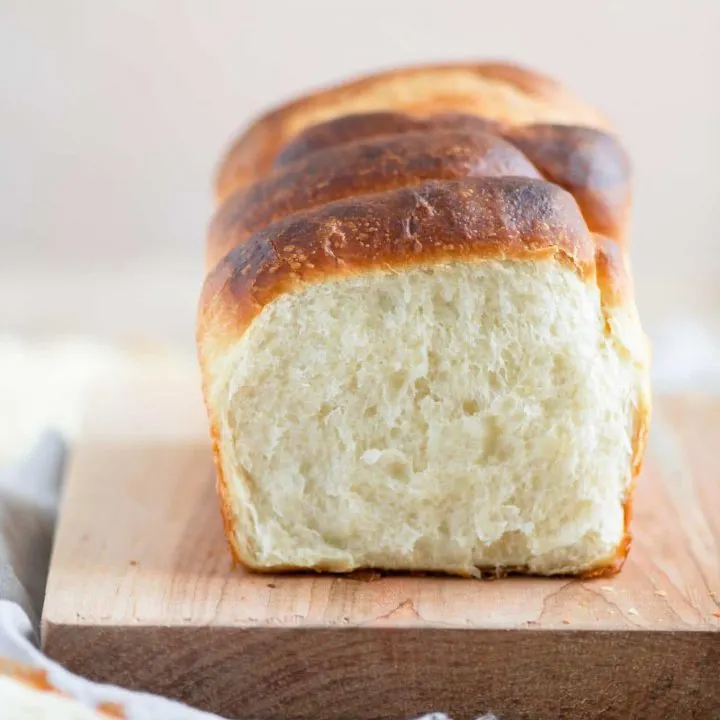
Vegan Brioche
Vegan brioche is as buttery, soft, and delicious as the traditional egg and butter laden loaves! It's delicious on its own, as toast, sandwiches, or for making french toast with the leftovers.
Ingredients
- 3 cups (416g) all purpose flour
- 3 cups (416g) bread flour
- 1/4 cup (48g) sugar
- 1 tsp (6g) salt
- 2 tsp (9g) instant yeast
- 1 3/4 cups (411g) plant milk (room temperature or cold)
- 3/4 cups (180g) silken tofu
- 2 tsp (10g) apple cider or white vinegar
- 12 tbsp (168g) vegan butter, softened (use up to 16 tbsp/226g for a richer loaf)
"egg wash"
- 2 tbsp plant milk
- 2 tsp maple syrup or agave nectar
- 1 tsp cornstarch
Instructions
Make the vegan brioche dough:
- In the bowl of a stand mixer or bread machine combine the all purpose and bread flours, sugar, salt, and instant yeast (see note below if using active dry yeast).
- Blend the silken tofu, plant milk, and vinegar together with a stick blender or upright blender until smooth. Add this to the dry ingredients and mix together with a wooden spoon until the dough is shaggy.
- Using the dough hook on the stand mixer knead the dough on low speed for 5 minutes to begin developing the dough. If using a bread machine, set it on the dough cycle and begin adding the vegan butter after 5 minutes of kneading.
- Slowly add the vegan butter while the mixer is on, just a couple tablespoons at a time. You may need to pause occasionally to scrape down the sides or push the soft butter into the dough manually. It can take up to 10 minutes to incorporate all of the butter.
- Once the butter has been kneaded in, let the mixer continue to knead for another 15-20 minutes to develop the dough. The silken tofu prevents you from being able to thinly stretch the dough into a window pane, but you will still see a smoother texture from the dough as it kneads.
- Turn the kneaded dough into a lightly oiled mixing bowl and turn the dough to coat in oil. Cover the bowl and let rise at room temperature for 1 hour, at which point it will be puffy and increased about 50% in size.
- Place the dough in the fridge and refrigerate for at least 4 hours but ideally overnight or up to 1 day.
Shape the dough:
- Grease two standard loaf pans (8.5 x 4.5 inches) with vegan butter. You can also use 9"x5" loaf pans.
- Take the refrigerated dough and divide it into 2 equal pieces to make 2 loaves of bread. Shape each piece of dough into your desired shape (see post for more details).
- To make a braid: Divide the dough into three equal pieces and roll out until about 14 inches long. Arrange the ropes parallel to each other and starting about 1/3 of the way down from the top start braiding the dough. When you reach the end pinch the pieces together. Then braid the top part of the dough, you will have to braid in the opposite way to match the lower half. Pinch the top ends together, then tuck both ends under the bread. Gently transfer the braid into the greased pan.
To make a segmented bread: Divide the dough into six equal pieces. Flatten each piece into a rectangle, then fold the short ends in like a letter. Flatten the dough to a rectangle once again (about as wide as the loaf pan) then roll the dough from the short end to make a log. Place each segment into the loaf pan seam side down, squishing them flatter to fit. - Cover the loaves with plastic wrap and let rise until about 1.5x as large, or the dough almost reaches the top of the pan. This will take 1-3 hours depending on ambient temperature.
Bake the loaves:
- Preheat the oven to 375 ºF.
- When the loaves have risen, optionally brush them with the vegan egg wash. This is most appropriate for sweet or neutral applications, skip for a savory dish. Mix together the plant milk, syrup, and cornstarch, then brush over the top of the proved loaves.
- Bake for 30-35 minutes, or until the top is golden and the center reaches 180-190 ºF.
- Remove the loaves immediately from the pans and let cool on a wire rack for a minimum of 20 minutes before slicing into.
Notes
If measuring the flour by volume: whisk the flour to undo settling, then scoop with a measuring cup and level with the backside of a butter knife.
If using active dry yeast instead of instant yeast it needs to be dissolved and proved in the liquid instead of being added directly to the flour. In this case add the yeast to the milk tofu mixture along with the sugar and let dissolve for 10 minutes before adding the liquids to the rest of the dry ingredients. It may not get super foamy and active because the liquids are cold.
Recommended Products
As an Amazon Associate and member of other affiliate programs, I earn from qualifying purchases.
Nutrition Information:
Yield: 24 Serving Size: 1Amount Per Serving: Calories: 193
Nutrition is calculated automatically so should be used as an estimate.
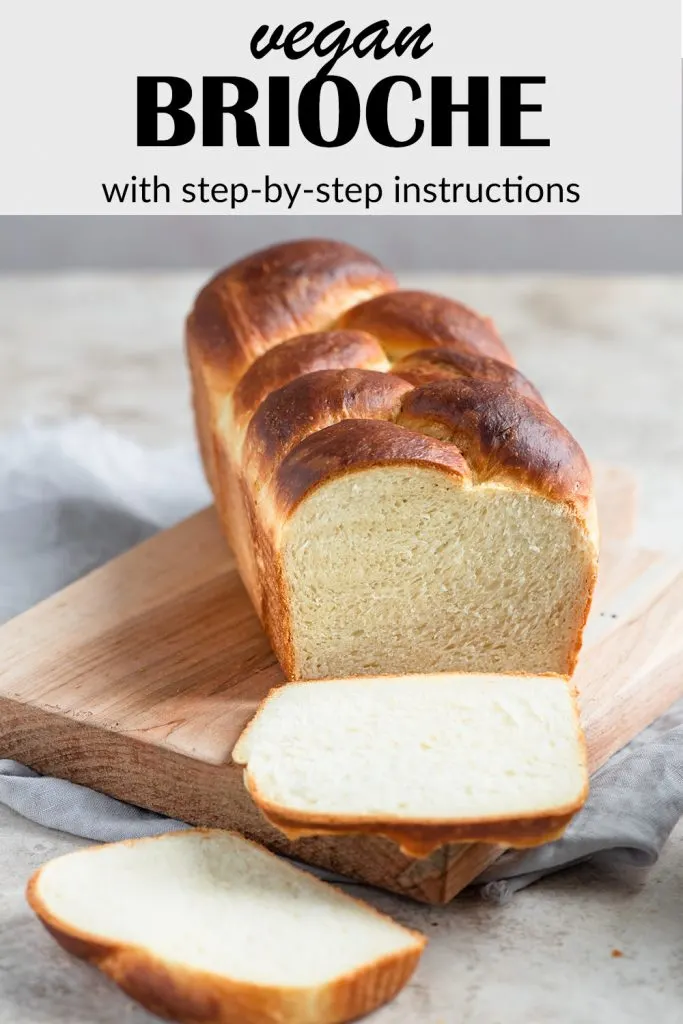


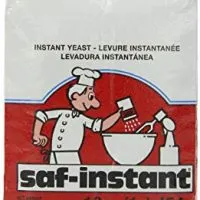

Cassia
Monday 11th of November 2024
Hello! Can you make these into dinner rolls? What would be the best way to do it.
Angelique
Sunday 30th of January 2022
Hi - because I am lazy, I threw all the ingredients into the bread maker and my goodness! The result is amazing! I had to take half the dough out and cook it in the oven. But the next time I used 1/2 this recipe and just threw it all in the breadmaker and put it on the brioche setting and it comes out so nice. Thank you so much!
Kris
Sunday 3rd of September 2023
@Angelique, I want to try this in my bread machine too, but mine doesn’t have a brioche setting. (It’s just an Amazon Basics brand one without any fancy settings outside of the, well, basics.) What setting would you suggest for this?
Elizabeth
Saturday 7th of August 2021
My 8-year-old and I made this together this weekend, and it turned out great even though we didn’t have bread flour on hand and subbed all purpose! She loved your braiding tutorial and is very proud of the loaf she braided all by herself.
Eva Agha
Wednesday 18th of August 2021
That's adorable! I'm so happy you two had success with the recipe :)
Linda
Sunday 17th of January 2021
How many eggs and is it the whole egg or just yolk to use instead of tofu? And how much regular butter? Not wanting vegan. But this looks too easy not to make. Thank you.
Eva Agha
Monday 18th of January 2021
I'm vegan and worked hard to create a vegan recipe of a traditionally very not-vegan bread. I can't advise on how to un-veganize this recipe, but there are plenty of non-vegan brioche recipes out there if you want to search for one of those.
Esha Batish
Friday 15th of January 2021
I don't know how you managed to create this recipe, but it's turned out perfect the two times that I've made it. I'm just so happy to be able to have brioche at home. Both times my breads were soft and fluffy, and the outside toasted just enough to form a sweet crust. I did make some tweaks. I used coconut oil instead of vegan butter, doubled the sugar and I put in a touch of turmeric as I've seen in other recipes, to Yellow the bread a little. Thank you so much for this recipe. It's easy, foolproof and makes simply delicious brioche!
Eva Agha
Monday 18th of January 2021
Hi Esha, that's amazing I'm so happy you've enjoyed making this brioche! I'm glad the coconut oil worked for you, thanks for reporting back and leaving the nice comment!